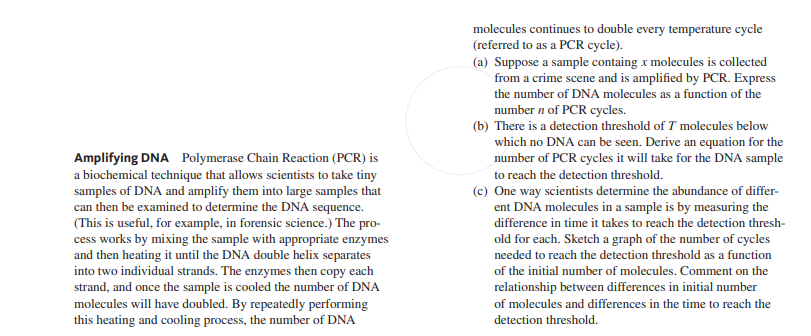molecules continues to double every temperature cycle (referred to as a PCR cycle). (a) Suppose a sample containg x molecules is collected from a crime scene and is amplified by PCR. Express the number of DNA molecules as a function of the number n of PCR cycles. (b) There is a detection threshold of T molecules below which no DNA can be seen. Derive an equation for the number of PCR cycles it will take for the DNA sample Amplifying DNA Polymerase Chain Reaction (PCR) is a biochemical technique that allows scientists to take tiny samples of DNA and amplify them into large samples that can then be examined to determine the DNA sequence. (This is useful, for example, in forensic science.) The pro- cess works by mixing the sample with appropriate enzymes and then heating it until the DNA double helix separates into two individual strands. The enzymes then copy each strand, and once the sample is cooled the number of DNA molecules will have doubled. By repeatedly performing this heating and cooling process, the number of DNA to reach the detection threshold. (c) One way scientists determine the abundance of differ- ent DNA molecules in a sample is by measuring the difference in time it takes to reach the detection thresh- old for each. Sketch a graph of the number of cycles needed to reach the detection threshold as a function of the initial number of molecules. Comment on the relationship between differences in initial number of molecules and differences in the time to reach the detection threshold.
molecules continues to double every temperature cycle (referred to as a PCR cycle). (a) Suppose a sample containg x molecules is collected from a crime scene and is amplified by PCR. Express the number of DNA molecules as a function of the number n of PCR cycles. (b) There is a detection threshold of T molecules below which no DNA can be seen. Derive an equation for the number of PCR cycles it will take for the DNA sample Amplifying DNA Polymerase Chain Reaction (PCR) is a biochemical technique that allows scientists to take tiny samples of DNA and amplify them into large samples that can then be examined to determine the DNA sequence. (This is useful, for example, in forensic science.) The pro- cess works by mixing the sample with appropriate enzymes and then heating it until the DNA double helix separates into two individual strands. The enzymes then copy each strand, and once the sample is cooled the number of DNA molecules will have doubled. By repeatedly performing this heating and cooling process, the number of DNA to reach the detection threshold. (c) One way scientists determine the abundance of differ- ent DNA molecules in a sample is by measuring the difference in time it takes to reach the detection thresh- old for each. Sketch a graph of the number of cycles needed to reach the detection threshold as a function of the initial number of molecules. Comment on the relationship between differences in initial number of molecules and differences in the time to reach the detection threshold.
Human Heredity: Principles and Issues (MindTap Course List)
11th Edition
ISBN:9781305251052
Author:Michael Cummings
Publisher:Michael Cummings
Chapter14: Biotechnology And Society
Section: Chapter Questions
Problem 12QP: DNA Profiles as Tools for Identification A PCR-based paternity test is conducted using STRs that...
Related questions
Question

Transcribed Image Text:molecules continues to double every temperature cycle
(referred to as a PCR cycle).
(a) Suppose a sample containg x molecules is collected
from a crime scene and is amplified by PCR. Express
the number of DNA molecules as a function of the
number n of PCR cycles.
(b) There is a detection threshold of T molecules below
which no DNA can be seen. Derive an equation for the
number of PCR cycles it will take for the DNA sample
Amplifying DNA Polymerase Chain Reaction (PCR) is
a biochemical technique that allows scientists to take tiny
samples of DNA and amplify them into large samples that
can then be examined to determine the DNA sequence.
(This is useful, for example, in forensic science.) The pro-
cess works by mixing the sample with appropriate enzymes
and then heating it until the DNA double helix separates
into two individual strands. The enzymes then copy each
strand, and once the sample is cooled the number of DNA
molecules will have doubled. By repeatedly performing
this heating and cooling process, the number of DNA
to reach the detection threshold.
(c) One way scientists determine the abundance of differ-
ent DNA molecules in a sample is by measuring the
difference in time it takes to reach the detection thresh-
old for each. Sketch a graph of the number of cycles
needed to reach the detection threshold as a function
of the initial number of molecules. Comment on the
relationship between differences in initial number
of molecules and differences in the time to reach the
detection threshold.
Expert Solution
This question has been solved!
Explore an expertly crafted, step-by-step solution for a thorough understanding of key concepts.
This is a popular solution!
Trending now
This is a popular solution!
Step by step
Solved in 2 steps

Follow-up Questions
Read through expert solutions to related follow-up questions below.
Follow-up Question
One way scientists determine the abundance of different DNA molecules in a sample is by measuring the difference in time it takes to reach the detection threshold for each. Sketch a graph of the number of cycles needed to reach the detection threshold as a function of the initial number of molecules. Comment on the relationship between differences in initial number of molecules and differences in the time to reach the detection threshold.
Solution
Recommended textbooks for you

Human Heredity: Principles and Issues (MindTap Co…
Biology
ISBN:
9781305251052
Author:
Michael Cummings
Publisher:
Cengage Learning

Human Heredity: Principles and Issues (MindTap Co…
Biology
ISBN:
9781305251052
Author:
Michael Cummings
Publisher:
Cengage Learning